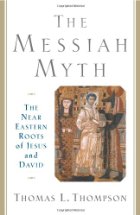*
Mythicist Claim Three: The Gospels Are Interpretive Paraphrases of the OT
.
COVERED IN THIS POST:
- The Gospels constructed out of scriptural midrash
- Jesus’ passion modelled on a traditional Jewish story
- The Gospel of the Old Testament according to Robert Price
- The Gospel Jesus as a new Moses
- A Jesus miracle modelled on Elijah
- What does the midrashic Gospel Jesus symbolize?
- Fictional episodes vs. the genuine article?
- Thomas L. Thompson and intertextual dependency
- What did Paul mean by “receiving” and “passing on”?
- Putting our trust in Luke and John
.
* * * * *
Claim 3: The Gospels Are Interpretive Paraphrases of the Old Testament
(Did Jesus Exist? pp. 197-207)
.
. . . . scholars began to realize that the events of the Synoptic Gospels were wholesale reworkings of elements and stories in Hebrew scripture.
Bart Ehrman now tackles perhaps the most momentous development in the entire history of New Testament scholarship, and it is a fairly recent one. While there were murmurs and insights in this direction beforehand, it was only around 1980 that scholars began to realize that the events of the Synoptic Gospels were wholesale reworkings of elements and stories in Hebrew scripture. A seminal work in this area was an article published in the Harvard Theological Review No. 73 (1980) by George Nickelsburg, entitled “The Genre and Function of the Markan Passion Narrative.”
.
The Gospels under a microscope
Nickelsburg first of all clinched the case that the entire Markan passion story is made up of building blocks extracted from the prophets and the Psalms, in some cases literally ‘chipped out’ of their scriptural settings and set into place in a new composition like a bricks-and-mortar construction.
Cleansing of the Temple
Thus, Hosea 9:15, “Because of their evil deeds I will drive them from my house,” and Zechariah 14:21, “No trader shall be seen in the house of the Lord,” became the literal building blocks of the Cleansing of the Temple scene.
Agony in Gethsemane
Psalm 42:5, “How deep I am cast in misery, groaning in my distress,” supplied Jesus’ agony in the garden of Gethsemane.
Beatings of Jesus
Isaiah 50:6-7, “I offered my back to the lash. . . I did not hide my face from spitting and insult,” was inserted literally and graphically into the picture of the ordeals which Jesus underwent.
Gambling for Jesus’ clothes
At the foot of the cross the soldiers gambled for Jesus’ garments because Psalm 22:18 said: “They divided my garments among them and for my raiments they cast lots.”
And so on.
There is scarcely a thread in the entire fabric of the passion story which has not been extracted from the scriptural tapestry. (In The Jesus Puzzle and Jesus: Neither God Nor Man I trace in detail the course of Mark’s passion story through its scriptural and literary sources.)
But it was not only at the nitty-gritty level that Mark used scripture to craft his story. Nickelsburg revealed that the overall shape of it followed a common generic model found in centuries of Jewish writing: Continue reading “24. Earl Doherty’s Response to Bart Ehrman’s Case Against Mythicism – Part 24”
Like this:
Like Loading...
 It’s good to see Professor Thomas L. Thompson come out and respond to Bart Ehrman’s crude dismissal of his scholarly contribution to the origin of the Christ myth.
It’s good to see Professor Thomas L. Thompson come out and respond to Bart Ehrman’s crude dismissal of his scholarly contribution to the origin of the Christ myth.